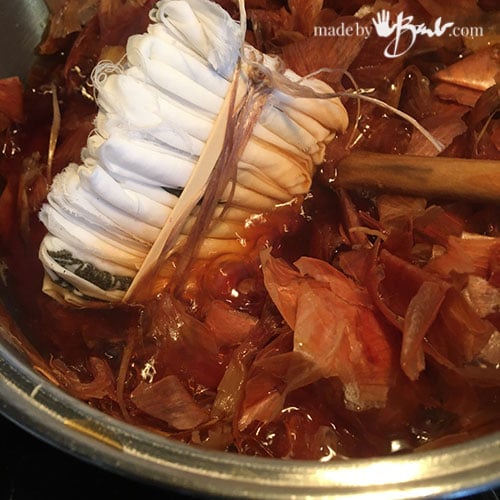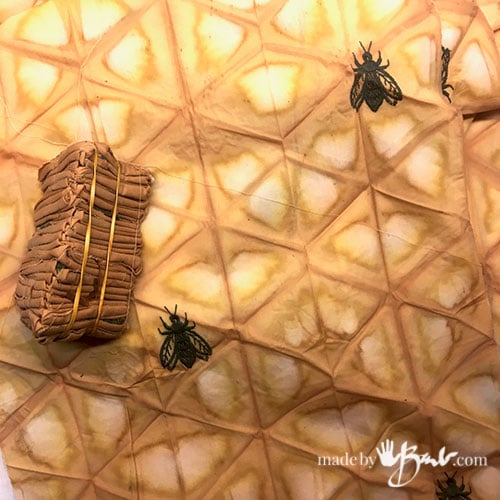Simple Onion Dye Shibori

Don’t think that you always need fancy supplies! As of late, using what I already have (you probably do too) makes some unique fabric for a project. See how you can create this Simple Onion Dye Shibori.

Oh, for the love of;
I hang on to fabric when I like it; but maybe I don’t have a purpose yet. This is an old Ikea curtain, 100% cotton with embroidered little bugs on it. How ‘stinkin’ cute is that?! I skipped a step of mordanting the fabric this time; ‘my bad’.
Shibori is the japanese art of folding and securing fabric to aid in creating unique patterns when dyed. Toss that term ‘Shibori’ around for your designer friends…
To start, accordion-fold the piece along the long way as close & precise as you can. I like work with it damp (and well washed).

Once it is neatly folded in the long direction then think equilateral triangle. Remember geometry in math class? It is a triangle with all three angles the same. It’s quite amazing how it flips back and forth to stack the triangle shapes. If you need to practice; folding paper helps.
See also my shibori pillows and duvet cover. The outer edges are what will be in contact with the dye so keep things pretty lined up, but in a sense perfection is not expected here. That’s what gives this shibori art form the charm in my opinion.

As you see I kept it very tiny this time as this has a purpose and also needs to fit in my small dye pot. But go ahead and go big if you like!

All Folded!
Don’t let go! Quick, secure it before it falls apart & you feel need to curse me…

Yes, elastic can work but for some reason they are not as reliable as they used to be. When learning how to get the most absolute tight ties on my geode tie-dyes I discovered faux sinew. It is waxed usually and will allow the most tight pulling (use a stick to wrap it around) and with multiple wraps it just clings to itself; no need for a knot. I love that!

Ready for the Onion Dye Plunge:
Super tight tied and amazing how much fabric is in there. I keep a mesh bag under my counter where I always put the brown onion skins. On wool and silk they create the most amazing reds.

To get strength in colour add as much onion skins as possible. Make sure there is enough water to keep everything submerged

Snuggle the bungles into the dye and simmer for as long as you can. The colour gets stronger over time. I let it sit sometimes when I can’t babysit it and then start it again. If you are not sure, you can fish one out and sneak a look into a fold. This is how I got such great dark Easter eggs.
There is option to add some iron sulphate but it really makes it dull and dark, so don’t add it.

The fun part:
No matter if it’s Eco Printing, Ice Dyeing or Tie-Dye, it’s always fun to open it up and see how amazing details magically appeared!

The colour combos of the Onion Dye Shibori are interesting with some slight green lines as well. Yes, rinse well and wash with a PH neutral soap/detergent. I like to use what they use on the ducklings – Dawn.

Once dried and ironed most dyed fabrics will lighten in colour but I have a purpose for this fabric…

Start with some cotton (has to be 100%) and end up with Onion Dye Shibori designer print. No purchasing needed! Can you guess what these will be? Check back soon to see Part #2
Don’t forget to save your onions skins…
Love this. Don’t you have to treat the fabric first?
I probably should have mordanted it but the project won’t involve washing soooo I sipped it this time. I am going to test another piece that was mordanted; and will update. Happy Dyeing!
So lovely! I’m going to guess that you’re going to wax the fabric to make food wraps. Just seems like that would fit with the theme 🙂
Masks maybe? Love all your creativity! Be safe!!!!!
Ok! I have to know! What are you making with this beautiful shibori print!
I’m saving onion skins starting today!
Warmly, Suzie
What do you think of when you see the colours? And the little bees? Beeswax? Hmmmm… maybe some beeswax wraps (shhhh, don’t tell anyone)
Thank you for all your generosity sharing your knowledge of eco printing. Every about it fascinates me. I’m a stained glass and glass fusing artist and all about color. My husband recently passed and I started eco printing on watercolor paper to make thank you cards ( which has turned into more cards) it helped me stay creative when I couldn’t be in my studio. Of course now I can’t stop!
Robin❤️
Sorry to hear about your husband. Yes, Eco printing is so addicting and ever-fascinating! I keep wanting to stop what I am doing and go print…
Did you rinse as soon as you took it out of the dye or let it dry then rinse and wash? I just did dyed scarves with leaves and flowers and I can’t get a good answer about rinsing and washing.. should the dye dry and set or is it OK to rinse. Will I lose all my color?
If it was properly mordanted, prepared and dyed, the needed process would be done. I don’t let them dry as drying doesn’t set the dye. I’m not sure what leaves or flowers so I can’t guarantee your dye. Best of luck.
I love your work, you are expert! i start learning Eco printing and enjoy very much but the results are very very pail. i understand that i can use Alum (aluminium sulphate) so it can improve the results .. but i don’t know the amount of the alum i put in the water if i want to soak the leaves and what amount of alum i put in the water to wet the cotton.. hope you can help me.
thank you very much .
For eco printing cotton one of the best mordants is Aluminum Acetate. Check this post for some info to make your own.
Blessed hands Barb 😊. Thank you very much for your awesome inspirations🥰. Do keep up the good work n keep on inspiring us🥰. God bless you 🙏🥰
Haha, you should actually see my hands! I have some very crooked fingers from many decades of making! I’ll keep at it as long as I can, please share to help me. Thanks!!